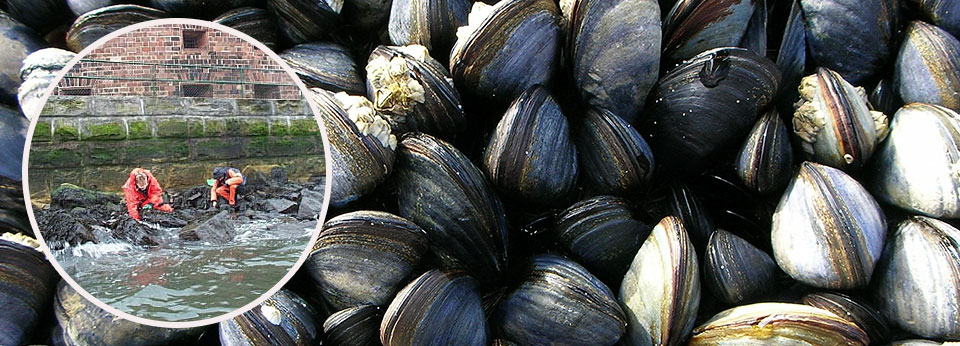NOAA Study: Oysters, Mussels Have Low Levels of Disease and Parasites
NOAA's first Mussel Watch report provides important new data for coastal researchers around the nation.

Bivalve Mollusks: Coastal "Canaries in the Coal Mine"
NOAA's Mussel Watch program samples mussels and oysters from over 300 sites around the coastal U.S. and the Great Lakes. By monitoring bivalve mollusks over time, scientists can keep close tabs on the health of the nation's coastal and marine waters. The researchers pictured here (inset) are collecting samples at the base of the Statue of Liberty in New York Harbor.
NOAA's first long-term report of the national distribution of parasites and disease in mussels and oysters, using data gathered between 1995 and 2009, provides a new data set for coastal resource management and shows the occurrence and severity of disease and parasite infections to be generally low nationwide during that time.
"The unprecedented baseline data in this new report will be vital for coastal managers as they look at degrading conditions in mussel and oyster population," said Dennis Apeti, the report's lead author and an oceanographer with NOS's National Centers for Coastal Ocean Science. "Environmental stressors, including unforeseen natural and human influenced events and climate change, continue to impact our coastal resources."
Apeti also said that the report's conclusions only reflect a limited number of parasites and disease that can affect bivalves, and that there are other tissue analyses in shellfish that the report does not assess. These include, amongst others, paralytic shellfish poisoning and fecal coliform bacteria, which both can pose significant threats to human health.
The report provides both national and regional trends. For example, oysters in the Gulf of Mexico and along the East Coast showed higher parasite levels than those in Puerto Rico or Hawaii. Also, West Coast mussels had significantly higher parasite levels than East Coast mussels. Zebra mussels, which are invasive in the Great Lakes, harbored few parasites and had significantly fewer cases of disease than all the other bivalves studied.
The program was initiated to monitor chemical contamination, but because the shellfish collected are also important commercial and recreational fisheries, Mussel Watch began monitoring disease and parasites in 1995 to provide additional management information to coastal resource managers. It also issued the first national assessment of flame-retardant chemicals in the U.S. coastal zone in 2009, showing they were widely distributed in both sediment and bivalve tissue and correlated with coastal population.
This report is part of the only continuous coastal monitoring program that is national in scope, the National Status and Trends Mussel Watch program which uses bivalve mollusks as "canaries in a coal mine" — sentinel organisms to monitor the health of the nation's coastal and marine waters including Alaska, Hawaii, Puerto Rico, and the Great Lakes.